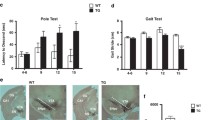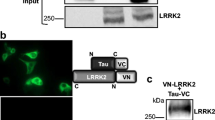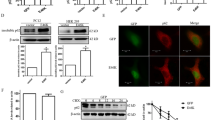Abstract
Hyperphosphorylated tau protein is the main component of neurofibrillary tangles found in Alzheimer's disease and Parkinson's disease (PD). Mutations in DJ-1 have been identified as the causative gene for Parkinson's disease 7 (PARK7)-linked PD. DJ-1L166P and DJ-1D149A, two types of DJ-1 mutations, are most commonly studied as the loss-of-function mutations responsible for early-onset familial PD. Whether mutations in DJ-1 result in tauopathy is as yet unknown. In this study, we found that the L166P and D149A mutant isoforms of DJ-1 associated with familial PD cause tau phosphorylation at Ser202, Ser262, and PHF1 (396/404) sites in neuroblastoma 2a cells. Glycogen synthase kinase (GSK)-3β phosphorylation at serine 9 (Ser9) decreases around 50 % in DJ-1L166P- or DJ-1D149A-transfected cells, while there is no change in total levels of GSK-3β. Our results also indicate that overexpression of DJ-1L166P or DJ-1D149A leads to a significant decrease in the level of phosphorylation of Akt at Thr308, which plays a critical role in phosphorylating GSK-3β at Ser9 and inhibiting its kinase activity. Importantly, insulin, the activator for Akt, effectively attenuates the reduced phosphorylation level of GSK-3β at Ser9 induced by DJ-1L166P. Neither the expression of cyclin-dependent kinase 5 nor the level of PP2A activity was found to have changed, suggesting that the familial PD-associated DJ-1L166P and DJ-1D149A mutations increase tau phosphorylation by increasing the activity of GSK-3β. Finally, we found that administration of lithium chloride, a well-known GSK-3β inhibitor, resulted in decreased levels of phosphorylated tau in DJ-1L166P-transfected cells.









Similar content being viewed by others
References
Aleyasin H, Rousseaux MW, Marcogliese PC, Hewitt SJ, Irrcher I, Joselin AP, Parsanejad M, Kim RH, Rizzu P, Callaghan SM, Slack RS, Mak TW, Park DS (2010) DJ-1 protects the nigrostriatal axis from the neurotoxin MPTP by modulation of the AKT pathway. Proc Natl Acad Sci 107:3186–3191
Biernat J, Gustke N, Drewes G et al (1993) Phosphorylation of Ser262 strongly reduces binding of tau to microtubules: distinction between PHF-like immunoreactivity and microtubule binding. Neuron 11:153–156
Bonifati V, Rizzu P, Squitieri F et al (2003) DJ-1 (PARK7), a novel gene for autosomal recessive, early onset Parkinsonism. Neurol Sci 24:159–160
Crizzle AM, Classen S, Uc EY (2012) Parkinson disease and driving: an evidence-based review. Neurology 79:2067–2074
Das G, Misra AK, Das SK et al (2012) Role of tau kinases (CDK5R1 and GSK3β) in Parkinson's disease: a study from India. Neurobiol Aging 33(1485):e9–e15
Deeg S, Gralle M, Sroka K et al (2010) BAG1 restores formation of functional DJ-1 L166P dimers and DJ-1 chaperone activity. J Cell Biol 188:505–513
Flaherty DB, Soria JP, Tomasiewicz HG et al (2000) Phosphorylation of human tau protein by microtubule-associated kinases: GSK-3beta and CDK-5 are key participants. J Neurosci Res 62:463–472
Gaig C, Ezquerra M, Marti MJ et al (2008) Screening for the LRRK2 G2019S and codon-1441 mutations in a pathological series of Parkinsonian syndromes and frontotemporal lobar degeneration. J Neurol Sci 270:94e8
Kim RH, Peters M, Jang Y, Shi W, Pintilie M, Fletcher GC, DeLuca C, Liepa J, Zhou L, Snow B et al (2005) DJ-1, a novel regulator of the tumor suppressor PTEN. Cancer Cell 7:263–273
Klawitter J, Klawitter J, Agardi E, Corby K, Leibfritz D, Lowes BD, Christians U, Seres T (2013) Association of DJ-1/PTEN/AKT- and ASK1/p38-mediated cell signalling with ischaemic cardiomyopathy. Cardiovasc Res 97:66–76
Kumaran R, Kingsbury A, Coulter I et al (2007) DJ-1 (PARK7) is associated with 3R and 4R tau neuronal and glial inclusions in neurodegenerative disorders. Neurobiol Dis 28:122–132
Moore DJ, Zhang L, Dawson TM et al (2003) A missense mutation (L166P) in DJ-1, linked to familial Parkinson's disease, confers reduced protein stability and impairs homo-oligomerization. J Neurochem 87:1558–1567
Moore DJ, West AB, Dawson VL et al (2005) Molecular pathophysiology of Parkinson's disease. Annu Rev Neurosci 28:57–87
Muntané G, Dalfó E, Martinez A et al (2008) Phosphorylation of tau and alpha-synuclein in synaptic-enriched fractions of the frontal cortex in Alzheimer's disease, and in Parkinson's disease and related alpha-synucleinopathies. Neuroscience 152:913–923
Nagao M, Hayashi H (2009) Glycogen synthase kinase-3beta is associated with Parkinson's disease. Neurosci Lett 449:103–107
Rizzu P, Hinkle DA, Zhukareva V et al (2004) DJ-1 colocalizes with tau inclusions: a link between Parkinsonism and dementia. Ann Neurol 55:113–118
Rosenmann H (2012) CSF biomarkers for amyloid and tau pathology in Alzheimer's disease. J Mol Neurosci 47:1–14
Sheng B, Wang X, Su B et al (2012) Impaired mitochondrial biogenesis contributes to mitochondrial dysfunction in Alzheimer's disease. J Neurochem 120:419–429
Taymans JM, Cookson MR (2010) Mechanisms in dominant Parkinsonism: the toxic triangle of LRRK2, alpha-synuclein, and tau. Bioessays 32:227e35
Tian Q, Wang J (2002) Role of serine/threonine protein phosphatase in Alzheimer's disease. Neurosignals 11:262–269
Ujiie S, Hatano T, Kubo S et al (2012) LRRK2 I2020T mutation is associated with tau pathology. Parkinsonism Relat Disord 18:819–823
Vincent EE, Elder DJ, Thomas EC, Phillips L, Morgan C, Pawade J, Sohail M, May MT, Hetzel MR, Tavaré JM (2011) Akt phosphorylation on Thr308 but not on Ser473 correlates with Akt protein kinase activity in human non-small cell lung cancer. Br J Cancer 104:1755–1761
Wang JZ, Liu F (2008) Microtubule-associated protein tau in development, degeneration and protection of neurons. Prog Neurobiol 85:148–175
Wang JZ, Grundke-Iqbal I, Iqbal K (2007) Kinases and phosphatases and tau sites involved in Alzheimer neurofibrillary degeneration. Eur J Neurosci 25:59–68
Yang Y, Ma D, Wang Y et al (2013) Intranasal insulin ameliorates tau hyperphosphorylation in a rat model of type 2 diabetes. J Alzheimer's Dis 33:329–338
Author information
Authors and Affiliations
Corresponding author
Rights and permissions
About this article
Cite this article
Wang, Y., Liu, W., He, X. et al. Parkinson's Disease-Associated Dj-1 Mutations Increase Abnormal Phosphorylation of Tau Protein through Akt/Gsk-3β Pathways. J Mol Neurosci 51, 911–918 (2013). https://doi.org/10.1007/s12031-013-0099-0
Received:
Accepted:
Published:
Issue Date:
DOI: https://doi.org/10.1007/s12031-013-0099-0




